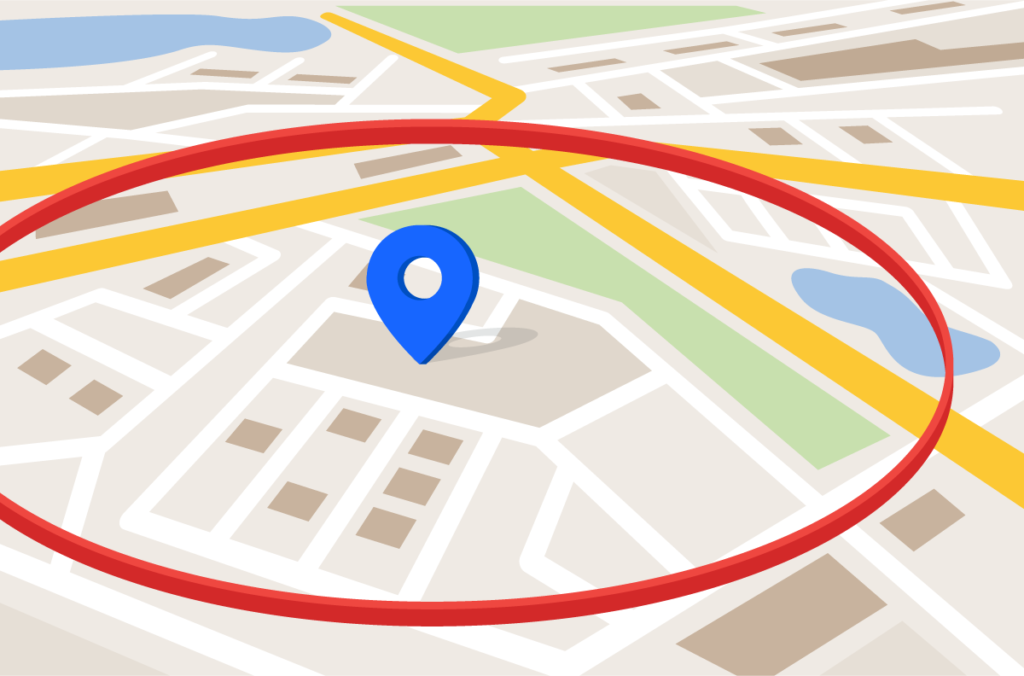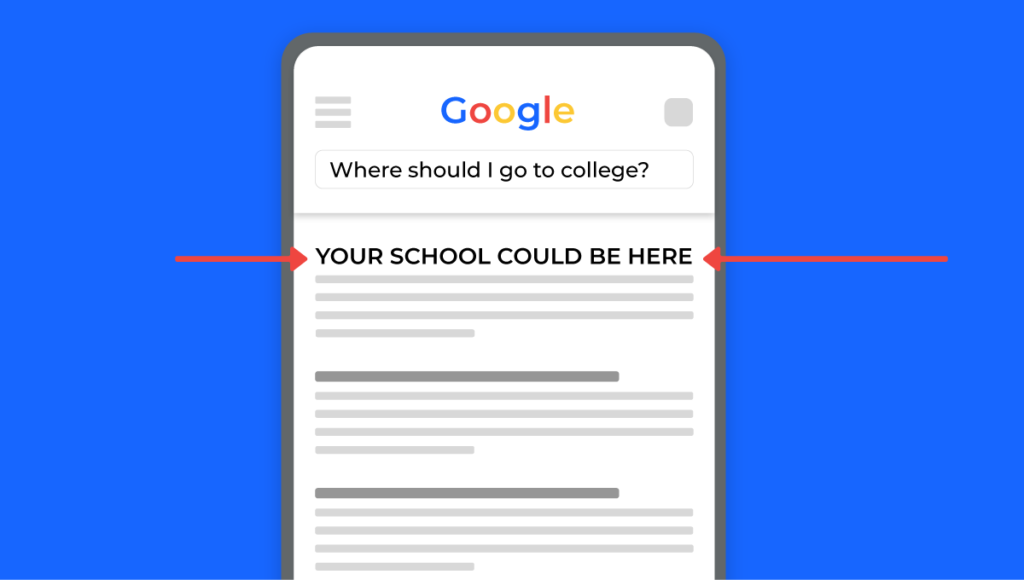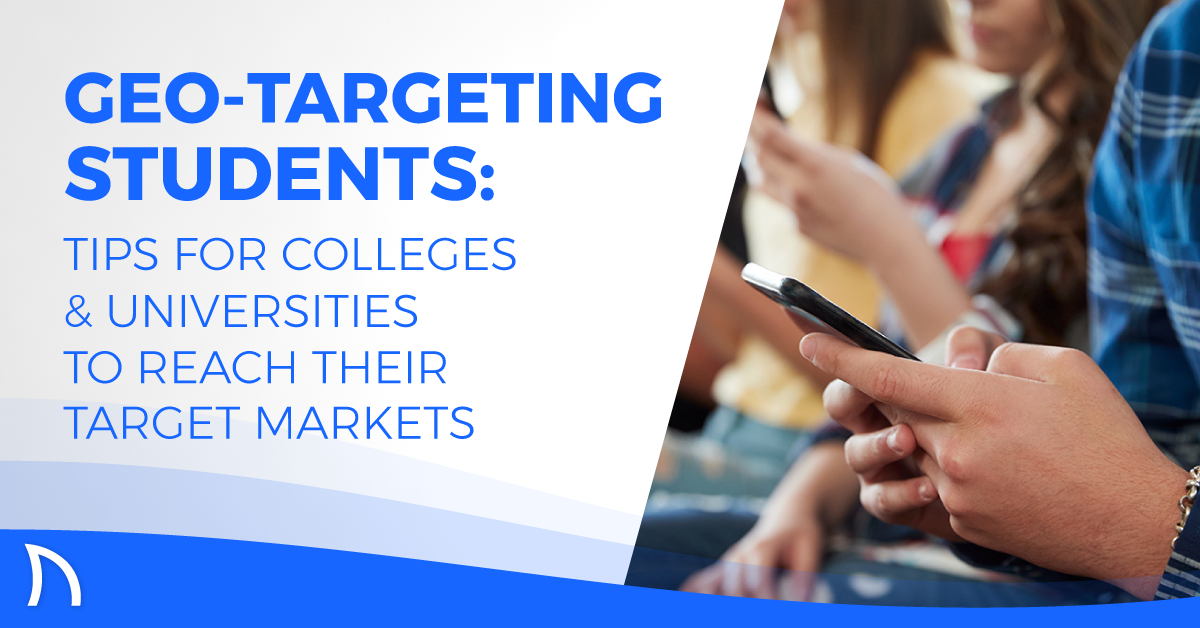Geo-Targeting Students: Tips for Colleges & Universities to Reach Their Target Markets
There are few people who feel more sought after than high school students who haven’t yet decided on which college to attend. I remember the days of coming home to postcards from local universities, getting e-mails from out-of-state schools, and networking with admissions reps at college fairs. I also still have several of the shirts from campuses I toured as a junior and senior in high school (if only they still fit!). Now, as a marketer, I have an even deeper sense of appreciation for the admissions departments and agencies behind these recruiting tactics.
As a digital marketing agency, we think it’s fundamentally important for higher ed institutions to have a good pulse on Google Ads and Facebook Ads so they can reach their target markets. One of the main things we get asked about is “geo-targeting.” This essentially refers to the practice of delivering relevant content to an individual based on their geographic location.
There are a few different ways for schools to target users based on location, including:
- Geofencing – which allows you to draw a virtual fence around a location and serve ads to mobile device users inside that area.
- Geoframing – whereby you collect mobile device IDs from users who have entered a predefined location at a specific time, and later serve them ads after they’ve left.
- Geolocation Targeting – where you’re able to target countries, cities, neighborhoods, or regions by postal code.
The ability to capture individuals who reside in areas of interest to you, or have visited locations that you deem relevant, makes digital marketing well worth the expense for recruitment efforts. Throughout the rest of this article, we’ll aim to provide you with an assortment of tips on how to increase the effectiveness of your student recruitment through geotargeting and digital advertising.
The Benefits of Geo-Targeting for College Student Recruitment

If you’ve been thinking about doing more geo-targeting through digital ads, including any mix of geofencing, geoframing, or location-based targeting, it’s important to have a full scope of the benefits of being able to reach your audience in this way. Digital advertising makes it easier than ever to target individuals based on location variables, and the advantages of doing so include:
- Provide more personalized messages. Let’s say, for example, that you want to get more specific with your location targeting of a growing metro. If there are 6 high-schools whose students you want to be able to reach with messages on their mobile devices, the ads may be even more potent if you call out direct messages that appeal to their school affiliation. You can set up a fence around a high school’s gym, and reach them with ads showing other students who attended that high school and have since gone on to your university. This is one of many ways that you can segment and provide more personalized content to students through geo-targeted ads.
- Reach new locations with greater ease. One of the biggest advantages of digital marketing is that it increases your ability to get your messages in front of audiences with greater ease. Through location-based targeting, you can reach out-of-state students with unique messages and offers related to your campus, or you can even target international students with information about your study abroad programs. Through Google Ads and Facebook Ads, you’ll find that it’s not only more convenient to reach new audiences, but it’s quite a bit more cost-effective (in comparison with traditional media).
- Retain a competitive advantage. Some clients may wish to put a geofence around a different college (competitor) to reach their foot traffic with mobile messages. These messages could include information about the ease of transferring to your campus (for existing students), or a call-to-action to schedule a tour (for undecided students). If you find value in advertising to those who have visited another school, this is a great tactic. Otherwise, you can also block your ads from showing up at another school, if you wish to retain a competitive advantage and not show other faculty or administrators the ads you’re running. Many people use geo-targeting as a way to retain a competitive advantage over others.
- Increase your local relevance. Geo-targeting is especially poignant for local audiences, as recent data suggests that the vast majority (around 70%) of public four-year college students attend an institution within two hours of their home. Ensuring that you can pull in local students will always be a big initiative, and using location-based targeting with your digital advertising efforts will help you stay locally relevant to those in your area. Though locals may already know enough about your campus or sports teams, maybe they want to learn more about specific programs or financial package options to compel them to apply.
These are just a handful of the many benefits that geo-targeting can have for those helping recruit and market on behalf of higher education institutions. Make sure that the content (videos, photos, articles) are high quality, and you’re well on your way to recruiting success through digital advertising.
How Colleges Can Effectively Use Paid Social Ads

In zoom meetings and socially-distanced board rooms across the country, right now, college administrators are meeting to discuss which social media platforms should be used and the content that should be posted. Coordinators are pitching getting a TikTok account to their directors, and admissions officers are requesting new videos to be made promoting specific studies. Truthfully, running a social media account on behalf of a school can feel quite daunting.
Though we only run organic social media accounts for our own brand, we have mastered the paid side of social media (digital ads run on Facebook, Instagram, Twitter, and more), and are happy to share our expertise on how to make “paid social” work for you.
- Identify which platforms your prospective students are on. Right now, we know that Gen Z is mostly on Instagram (about 73%), Snapchat (63%), and YouTube (62%) according to a recent Adobe study. Being able to reach individuals on these platforms should be prioritized more than LinkedIn, Twitter, and Facebook (besides, of course, the fact that Facebook is tied to Instagram and you can run IG ads through Facebook’s ad platform).
- Familiarize yourself with the advertising side of each platform. In an ideal world, all of your prospects would follow you on your social accounts and see your organic content. But if the year 2020 has taught us anything it’s that we don’t live in an ideal world. So, instead, you need to get more savvy and learn what you can about Facebook Ads, Instagram Ads, Snapchat Ads, YouTube Ads, Twitter Ads, LinkedIn Ads, and even TikTok Ads to feel prepared.
- Identify the budget you’re willing to spend. You’re far more familiar with your marketing budget than we are, but the only advice I would pass along is: start small and scale up. Determine how much you’re willing to spend to get a “lead” (applicant), and build up your budget accordingly. If you’re willing to spend $20 to receive an application, and you can tie a cost per lead together that is at or below this mark, it’ll guide your ability to increase your spend accordingly.
- Produce creative that works. We’re an agency that is happy to assist with the creation of imagery & copywriting that can earn you conversions, but it’s also important to be mindful of when to switch things up. On Facebook, for example, if your frequency number (or how often the same person sees your ad) rises too much, your ad will lose its effectiveness. Keep a watchful eye on frequency and ensure that you’re doing what you can to not exceed a frequency of ~3.
- Diversify your targeting. From creating lookalike audiences to targeting based on life events, there are a lot of unique ways to reach individuals on Facebook and other social media platforms. However, for the sake of this article being about location-based targeting, I’ll keep it simple: target unique locations with unique messages. You can get quite granular with your geo-targeting on social media, even being able to drop pins and create 1-mile radiuses you wish to stay within.
- Remarket with the best of them. Have you ever checked out a shoe online and then gone to Facebook and seen that exact same shoe advertised to you? It’s not magic, it’s retargeting. By installing Facebook Pixel
- Track, optimize, repeat. Data leads everything these days, and you should take advantage of the data that you have access to. Quantify items like cost per lead (cost of each application or conversion) and cost per acquisition (cost of turning that lead into an enrolled student) to help shape the decisions for future social media ads. You should be making routine changes to your ad groups based on performance, and continually improve the success of your campaigns. Switch up targeting and creative as necessary.
It’s our belief that Facebook’s advertising platform is one of the most robust of any social media (or, really, any advertising) platform. Though less and less high school students are on Facebook, it is also connected to Instagram which is where a lot of teens and young adults can be found. If you need any assistance with your paid search campaigns for your college or educational institution, we’d be happy to help. Drop us a line to learn about how we can improve your paid social advertising.
Take Advantage of Google’s Geo-Targeting Capabilities for Recruiting

Advertising through Google, Bing, or other paid search platforms can create new opportunities for your institution to be seen. However, it’s also an expansive platform with many different ad types, targeting options, and other variables to consider. If you need help with your Google Ads, reach out to our team and we’d be happy to assist you. If you’re a little nervous to reach out and want to do your own research first, we hope you’ll find this next portion (about geo-targeting on Google) to be helpful. Here are some important things to consider:
- What locations can I target
- “Countries” – if you are open to targeting an entire country (either your own country for domestic enrollment, or a foreign country to talk about study abroad/international options), you will have your best chance at ad exposure. However, it can also be the most likely to exhaust your budget (due to that increased exposure and more clicks).
- “Areas within a country” – this is what Google refers to as the cities, regions, or postal codes you can use to target your ad to. It’s a more granular option than locating based on country, and allows you to be more specific with the audience you’re aiming to reach.
- “Radius around a location” – this allows you to show your ads to customers within a certain distance of specific landmarks (like your college, other schools, malls and shopping centers, and more). It’s the most specified way to reach your audience which means it may have the lowest exposure, but it will (if done correctly) give you the most bang for your buck by reaching a highly potent location.
- What ad types can I run for geo-targeting
- Search Ads – these are results that show up on keyword searches, for example when somebody searches “college application.” You’re able to bid on these ads and only have yours show for specific geographic areas that you display.
- Display Ads – these are images that are displayed across an array of different sites, mobile apps, and gmail inboxes that are part of the Google Display Network. We’ve got even more information about designing responsive display ads here, but it’s also important to know that you can target these ads to only show up to people in specific geographic locations, too.
- YouTube Campaigns – on video campaigns, you are able to target based on a variety of different demographic variables (including detailed demographics like college students). You can also do location-based targeting for ads that run on YouTube.
- How to get location targeting setup on Google Ads
- Select the campaign you wish to modify, and click the “Settings” tab
- Scroll down to “Locations and Languages” and then click “edit” underneath “Locations”
- Search for your location (state, province, city, postal code) and then click on the result you were looking for
- Select “Add” for any you wish to add to your list of targeted locations
- Select “Exclude” for any you wish to prevent from seeing your ads
- Select “Nearby” to generate a list of nearby regions you would want to add, too
- Otherwise, you can also go to the “Radius targeting” tab (instead of search tab) and enter in a location that would become the center of the radius. Make edits to the distance around the location you wish to target
- Best practices for Google geo-targeting
- Don’t get too carried away – the technology is pretty awesome, but don’t run too many small campaigns with small budgets because it will become very difficult for you to keep a handle on all of them.
- Get responsive – with both search and display, try “responsive ads” that will optimize to show the best creative (either ad copy or imagery) that gets you the best results.
- Try out different markets – run separate campaigns for the markets that you are curious about; see how you perform in local/in-state campaigns as opposed to regional/national campaigns in markets of interest.
- Include negative locations – just like you can do negative keywords (identifying words/phrases you don’t want to bid on), also consider negative locations. Are there any cities, states, or even locations in your community that are not worth reaching for various reasons? Don’t waste your ad spend on those.
- Try out different targeting methods – you can target based on people in your target location, or people who show interest in your target location (but are not there currently). If there is someone from out-of-state who is searching for more information about the state you’re in, they may be a good group to advertise to.
- Use data to optimize – don’t just set it and forget it. Create a Google Data Studio dashboard, or at the very least use the reports that you can generate directly in the Ads platform. Make routine changes to your targeting based on the results, and phone a friend when you need a hand.
There are a plethora of opportunities for colleges, universities, and other higher ed institutions to take advantage of location-based targeting in their digital ads. Through both paid social and paid search, you’ll have an awesome opportunity to tap into potential students. If you wish to learn more about AdShark’s experience helping organizations like yours get rolling with their digital advertising strategy, please feel free to shoot us a message. We’d love to chat!
Ready To Grow?
Let's Talk!


